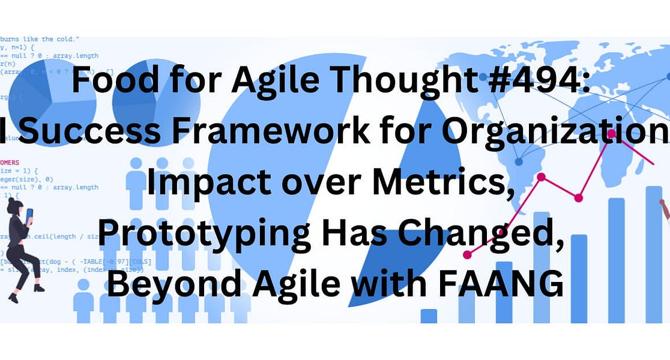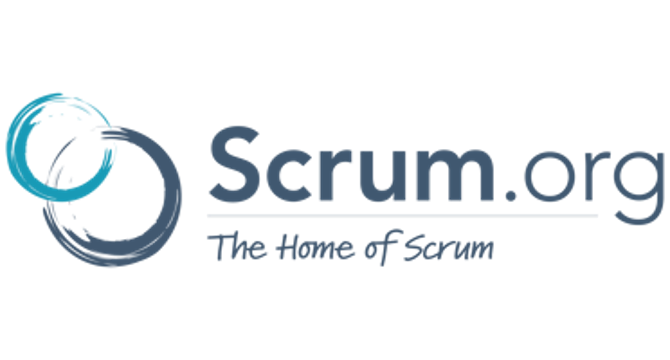Agile Methodology News
Medium
221

Image Credit: Medium
Beyond Frameworks and Templates: What Product Managers Are Truly Accountable For
- Product managers can face conflicting advice on technical knowledge and the use of tools like Jira and Trello in their roles.
- Understanding the value behind frameworks and rituals is crucial for product managers to make informed decisions.
- Product managers must focus on creating meaningful customer value and ensuring it leads to measurable business impact.
- Training programs for product managers should emphasize core responsibilities and practical application over theoretical frameworks.
Read Full Article
13 Likes
Dev
290

Image Credit: Dev
🧠 The Silence That Shipped Nothing: A Psychological Postmortem of My Fake Startup
- A fake startup called Whispr, offering 'Silence-as-a-Service,' was created as a parody of Silicon Valley's obsession with productivity and clarity.
- The Whispr platform implemented silent productivity, replacing meetings with ambient presence and using fake metrics like Neural Quietude Index™ and Void Engagement Coefficient.
- The experiment led to requests for the Whispr SDK, inquiries about its availability, and offers for brand collaboration, blurring the line between parody and reality.
- Whispr sheds light on the noise economy in tech and the social theater of work, showcasing how silence can reveal the underlying rituals and mysticism present in the industry.
Read Full Article
17 Likes
Medium
355

Image Credit: Medium
Agile Sprints vs. Organizational Marathons: Bridging the Planning Gap
- Agile development emphasizes short sprints for quick wins and adaptability, while executives focus on long-term planning and strategy.
- Many companies embracing Agile have faced challenges in maintaining strategic planning and alignment to long-term objectives.
- Misinterpretation of Agile principles, such as prioritizing response to change over following a plan, can lead to a lack of strategic planning.
- The disconnect between rapid sprints and long-term objectives can hinder strategic alignment and product success, risking the company ending up off course.
Read Full Article
21 Likes
Hackernoon
273

Image Credit: Hackernoon
Your Agile Team Doesn’t Need Another AI Tool—It Needs Fewer Questions With Better Answers
- The focus on launching new AI tools for Agile teams may not address the core issue of lack of clarity within the team.
- Teams often struggle not due to speed but because of a lack of alignment on the project's goals and objectives.
- While AI tools can be beneficial in Agile processes, they are only truly effective if the team is already asking the right questions and maintaining clear communication.
- Rather than adding more AI tools, the emphasis should be on asking better questions within the team and creating space for meaningful discussions to ensure alignment and clarity.
Read Full Article
16 Likes
Discover more
- Programming News
- Software News
- Web Design
- Devops News
- Open Source News
- Databases
- Cloud News
- Product Management News
- Operating Systems News
- Computer Engineering
- Startup News
- Cryptocurrency News
- Technology News
- Blockchain News
- Data Science News
- AR News
- Apple News
- Cyber Security News
- Leadership News
- Gaming News
- Automobiles News
Medium
166

Image Credit: Medium
Food for Agile Thought #494: AI Success Framework for Organizations, Impact over Metrics…
- Ethan Mollick introduces Leadership-Lab-Crowd-based AI Success Framework for organizational change.
- Greg Nudelman suggests replacing ego-bound product managers to boost innovation.
- Aparna Chennapragada at Microsoft talks about AI prototyping and NLX reshaping the PM role.
- Various experts discuss the limits of AI, failed A/B tests in SaaS growth, no-code AI prototyping, and more.
Read Full Article
10 Likes
TechBullion
119

Image Credit: TechBullion
Sagar Gupta: Orchestrating Enterprise Evolution Through Holistic Agile ERP Innovation
- The contemporary business landscape demands agility and evolution from Enterprise resource planning (ERP) systems.
- Sagar Gupta, an ERP Implementation Leader, champions a holistic Agile approach in orchestrating ERP transformations.
- His methodology integrates Agile and DevOps, minimizes customization, and leverages AI/ML-driven analytics and Industry 4.0 technologies.
- Gupta emphasizes strategic integrations to enhance real-time decision-making across business functions.
- His approach focuses on avoiding excessive customization that leads to increased costs, upgrade challenges, and diminished vendor support.
- Gupta's methodology also includes adopting containerization, orchestration, and Infrastructure-as-Code for scalable and efficient ERP deployments.
- He advocates for a 'just-right' customization strategy, aligning customizations with unique value-chain differentiators for maximum ROI.
- Gupta's leadership has resulted in significant improvements in operational efficiency, infrastructure costs, and productivity, driven by deliberate technological choices.
- His integration of AI/ML into ERP systems enables real-time prescriptive analytics and tangible business benefits, such as improved stock management.
- Gupta's strategy for IoT integration involves a Lambda architecture for high-throughput data management and Apache Flink for real-time anomaly detection.
- He envisions the future of ERP systems as distributed, autonomous coordination layers powered by intelligent agents, deeply integrated with AI and Industry 4.0 technologies.
Read Full Article
7 Likes
Scrum-Master-Toolbox
359

Deniz Ari: Why Great Product Owners Listen—Communication Lessons from Product Ownership Extremes
- Deniz shares insights on a remarkable Product Owner who excelled in communication skills by listening effectively, articulating requirements clearly, and fostering team motivation.
- In contrast, Deniz discusses a challenging experience with a tyrant Product Owner who lacked communication skills, pushed the team beyond limits, and created a toxic work environment.
- The importance of establishing boundaries with dominant Product Owners and recognizing when situations cannot be improved is highlighted for agile professionals.
- Deniz Ari emphasizes the crucial role of communication in product ownership extremes, underlining how effective communication bridges the gap between teams, clients, and project success.
Read Full Article
21 Likes
Medium
38

Image Credit: Medium
Don’t Focus on Velocity, But Quality.
- Improving delivery speed in Agile does not necessarily increase customer satisfaction, as creating a rhythm for iterative delivery is more critical for overall performance.
- The rhythm of how and how often a team delivers value to customers is crucial, with constant and consistent business value being the true goal.
- Success is attributed to daily habits rather than one-time transformations, emphasizing the importance of consistent practices over pure speed or effort.
- Based on experience as a Scrum Master/Agile coach, the key principle is to focus on quality over velocity to avoid projects getting overwhelmed with bugs and slowing down.
Read Full Article
2 Likes
Scrum
402

Image Credit: Scrum
The Three-horizon Approach to Sprint Planning
- Teams often focus on the current Sprint goals, but what if they planned across all three horizons of innovation within each Sprint?
- A suggested structure includes allocating 60% to Horizon 1 (Business as Usual), 30% to Horizon 2 (Sustaining Innovation), and 10% to Horizon 3 (Disruptive Innovation).
- This approach encourages teams to think beyond immediate tasks, dedicating time to experiments, improvements, and explorations for future readiness.
- By incorporating all three horizons into their Sprint planning, teams can become more vision-aligned, future-conscious, and resilient in their approach.
Read Full Article
24 Likes
Scrum
300

Image Credit: Scrum
Scrum Isn’t Complete Without This One Ingredient: Collective Intelligence
- Scrum is built upon by the collective intelligence of the people using it, as per the Scrum Guide.
- Collective intelligence in Scrum involves everyone contributing insights, making decisions together, welcoming diverse opinions, visible learning, and natural continuous improvement.
- Challenges to achieving collective intelligence in Scrum include command-and-control environments, knowledge hoarding, fear of conflict, and running Scrum by rote.
- Practical ways to help Scrum Teams tap into collective intelligence include framing Scrum Events as learning opportunities, running experiments, using facilitation techniques, and challenging assumptions openly.
Read Full Article
18 Likes
Scrum
412

Image Credit: Scrum
Sprint Capacity Planning for Scrum Teams: A Practical Guide
- Sprint capacity planning is crucial for Scrum Teams to effectively plan their next iteration.
- Team capacity planning determines the amount of work a team can complete in the next Sprint.
- Factors like team size, focus level, individual availability, and iteration length impact team capacity.
- External distractors and changes in team composition also influence team capacity.
- Practical examples are provided to calculate team capacity using key variables like team size and unit of effort.
- Capacity planning should not be an excuse for team failure; the team is responsible for delivering a valuable Increment every Sprint.
- Capacity planning is not about fully utilizing team members but maximizing value from problem-solving.
- It is a complementary practice for Scrum Teams, and its usage can vary among teams based on their needs.
- Scrum and Kanban implementation support are available for digital, business, and Agile transformations.
- The article cites Essential Scrum: A Practical Guide to the Most Popular Agile Process by Kenneth S. Rubin.
Read Full Article
24 Likes
Scrum-Master-Toolbox
416

Deniz Ari: Stakeholder Management Rhythms for Successful Scrum Masters
- Successful Scrum Masters create environments with positive team dynamics, open communication, and a focus on continuous improvement, which leads to valuable deliverables.
- Key indicators include team members freely expressing themselves, trust among team members, and a safe space for failure.
- Deniz recommends modeling vulnerability by admitting mistakes, observing team interactions, and encouraging open discussion of obstacles.
- For stakeholder management, Deniz suggests regular catch-up calls with leaders to align team messages and routine discussions with stakeholders for alignment.
Read Full Article
25 Likes
Medium
395

Image Credit: Medium
Why IT Teams Are Moving Away from Traditional PMOs — and How to Evolve for Success
- PMOs and organizations need to pivot away from outdated practices and adopt new strategies to stay relevant.
- PMO professionals must upskill and adapt by developing key skills to thrive in the evolving landscape of project management.
- The shift away from traditional PMOs signifies the need for evolution towards empowering teams, fostering innovation, and focusing on delivering value quickly.
- To succeed, organizations must foster a culture of collaboration and continuous improvement, while PMO professionals should learn new skills to stay relevant in a product-driven world.
Read Full Article
23 Likes
Medium
275

#ReTHINKscrum — The Scrum Master’s Role in Helping Product Owners Think Beyond the Backlog
- Product planning in complex environments isn't about prediction, but sensemaking.
- Scrum Masters need to challenge predictive thinking and restore agility to the product mind.
- They should focus on enabling experiments, shifting from outputs to outcomes, and understanding the system the Product Owner is trapped in.
- Scrum Masters play a crucial role in helping Product Owners think empirically and plan for the future in uncertain environments.
Read Full Article
16 Likes
Kanbanzone
25

Image Credit: Kanbanzone
Thinking More Organisationally About Process
- The essence of 'thinking organisationally' involves focusing on the relationships between different aspects of the organization and ensuring they are functioning effectively.
- Applying this concept to a Kanban board involves considering each vertical line as a relationship between upstream and downstream activities.
- By analyzing these relationships, teams can identify and address problems such as process steps being done at the wrong time or by the wrong people.
- Teams can optimize collaboration by distinguishing between coordinating, cooperating, and collaborating across vertical lines based on the nature of the work.
- Reflecting on whether the default modes of coordination, cooperation, and collaboration were effective can lead to improved decision-making and workflow.
- Addressing failures of flow and context in work processes can prevent issues from escalating into leadership failures and enhance organizational resilience.
- Emphasizing the importance of context in decision-making and promoting relevant conversations within and outside the team can strengthen organizational capabilities.
- A comprehensive understanding of relationships and context can lead to better preemptive measures and improve overall organizational adaptability.
- The author's book 'Wholehearted: Engaging with Complexity in the Deliberately Adaptive Organisation' delves into these concepts to guide organizations towards effective management practices.
Read Full Article
1 Like
For uninterrupted reading, download the app